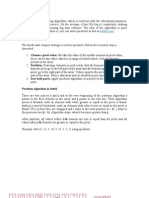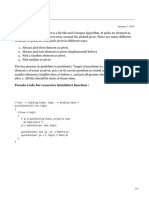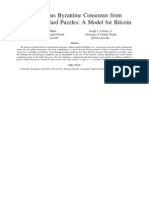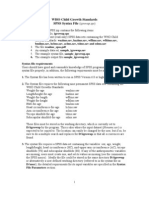Quick Sort Algorithm
Uploaded by
AMITS CHAUHANQuick Sort Algorithm
Uploaded by
AMITS CHAUHANDATA STRUCTURE - QUICK SORT
http://www.tutorialspoint.com/data_structures_algorithms/quick_sort_algorithm.htm Copyright © tutorialspoint.com
Quick sort is a highly efficient sorting algorithm and is based on partitioning of array of data into
smaller arrays. A large array is partitioned into two arrays one of which holds values smaller than
specified value say pivot based on which the partition is made and another array holds values
greater than pivot value.
The quick sort partitions an array and then calls itself recursively twice to sort the resulting two
subarray. This algorithm is quite efficient for large sized data sets as its average and worst case
complexity are of Onlogn where n are no. of items.
Partition in Quicksort
The below given animated representation explains how to find pivot value in the array.
The pivot value divides the list in to two parts. And recursively we find pivot for each sub-lists until
all lists contains only one element.
QuickSort Pivot Algorithm
Based on our understanding of partitioning in quicksort, we should now try to write an algorithm
for it here.
Step 1 − Choose the highest index value has pivot
Step 2 − Take two variables to point left and right of the list excluding pivot
Step 3 − left points to the low index
Step 4 − right points to the high
Step 5 − while value at left is less than pivot move right
Step 6 − while value at right is greater than pivot move left
Step 7 − if both step 5 and step 6 does not match swap left and right
Step 8 − if left ≥ right, the point where they met is new pivot
QuickSort Pivot Pseudocode
The pseudocode for the above algorithm can be derived as −
function partitionFunc(left, right, pivot)
leftPointer = left -1
rightPointer = right
while True do
while A[++leftPointer] < pivot do
//do-nothing
end while
while rightPointer > 0 && A[--rightPointer] > pivot do
//do-nothing
end while
if leftPointer >= rightPointer
break
else
swap leftPointer,rightPointer
end if
end while
swap leftPointer,right
return leftPointer
end function
QuickSort Algorithm
Using pivot algorithm recursively we end-up with smaller possible partitions. Each partition then
processed for quick sort. We define recursive algorithm for quicksort as below −
Step 1 − Make the right-most index value pivot
Step 2 − partition the array using pivot value
Step 3 − quicksort left partition recursively
Step 4 − quicksort right partition recursively
QuickSort Pseudocode
To get more into it, let see the pseudocode for quick sort algorithm −
procedure quickSort(left, right)
if right-left <= 0
return
else
pivot = A[right]
partition = partitionFunc(left, right, pivot)
quickSort(left,partition-1)
quickSort(partition+1,right)
end if
end procedure
To see quick sort implementation in C programming language, please click here.
Loading [MathJax]/jax/output/HTML-CSS/jax.js
You might also like
- Data Structure and Algorithms Quick SortNo ratings yetData Structure and Algorithms Quick Sort3 pages
- 28 - Data Structure and Algorithms - Quick SortNo ratings yet28 - Data Structure and Algorithms - Quick Sort5 pages
- Data Structure and Algorithms Quick SortNo ratings yetData Structure and Algorithms Quick Sort2 pages
- QuickSort (With Code in Python-C++-Java-C)No ratings yetQuickSort (With Code in Python-C++-Java-C)13 pages
- How Does Quicksort Work?: Conquer CombineNo ratings yetHow Does Quicksort Work?: Conquer Combine10 pages
- Course Name: CS302-Design An Analysis of Algorithm: Credit Hours: 3No ratings yetCourse Name: CS302-Design An Analysis of Algorithm: Credit Hours: 340 pages
- Design & Analysis of Algorithms: Submitted To Prof. Hashim Javed Submitted by Affifa ID: 30 21-Aug-2019No ratings yetDesign & Analysis of Algorithms: Submitted To Prof. Hashim Javed Submitted by Affifa ID: 30 21-Aug-201911 pages
- Lecture Slide 8 DAA - Handout-Divide & Conquer - Quick SortNo ratings yetLecture Slide 8 DAA - Handout-Divide & Conquer - Quick Sort21 pages
- Quicksort: Pseudo Code For Recursive Quicksort FunctionNo ratings yetQuicksort: Pseudo Code For Recursive Quicksort Function11 pages
- Quick Sort: I L J r+1 Do ++i While (A (I) Pivot && I R)No ratings yetQuick Sort: I L J r+1 Do ++i While (A (I) Pivot && I R)6 pages
- LAB211 Assignment: Title Background ContextNo ratings yetLAB211 Assignment: Title Background Context3 pages
- Quick Sort: As The Name Implies, It Is Quick, and It Is The Algorithm Generally Preferred For SortingNo ratings yetQuick Sort: As The Name Implies, It Is Quick, and It Is The Algorithm Generally Preferred For Sorting21 pages
- SP24-DS&A-Week03-Sorting-Data-StructuresNo ratings yetSP24-DS&A-Week03-Sorting-Data-Structures30 pages
- Quick Sort: Presented By: Shivani (B-Tech Cse)No ratings yetQuick Sort: Presented By: Shivani (B-Tech Cse)11 pages
- Design & Analysis of Algorithms: DR Anwar GhaniNo ratings yetDesign & Analysis of Algorithms: DR Anwar Ghani35 pages
- Backpropagation: Fundamentals and Applications for Preparing Data for Training in Deep LearningFrom EverandBackpropagation: Fundamentals and Applications for Preparing Data for Training in Deep LearningNo ratings yet
- ID526c8fc13-2012 Honda Civic Manual Vs AutomaticNo ratings yetID526c8fc13-2012 Honda Civic Manual Vs Automatic2 pages
- Online Pre - Assessment Job Application System For PHIL-TEX Staffing Services International Inc0% (1)Online Pre - Assessment Job Application System For PHIL-TEX Staffing Services International Inc8 pages
- Tutorial To Compile Trojan Source Code and Embed It Into A Carrier File100% (2)Tutorial To Compile Trojan Source Code and Embed It Into A Carrier File7 pages
- M.B.A. (Full Time) Semester - I - Result - 2010: Subject Code Theory Marks Practical Marks Ses. Marks Total MarksNo ratings yetM.B.A. (Full Time) Semester - I - Result - 2010: Subject Code Theory Marks Practical Marks Ses. Marks Total Marks8 pages
- Anonymous Byzantine Consensus From Moderately-Hard Puzzles: A Model For BitcoinNo ratings yetAnonymous Byzantine Consensus From Moderately-Hard Puzzles: A Model For Bitcoin8 pages
- Manufacturing and Production Planning Table of ContentsNo ratings yetManufacturing and Production Planning Table of Contents4 pages
- Finding The Dimension and Basis of The Image and Kernel of A Linear TransformationNo ratings yetFinding The Dimension and Basis of The Image and Kernel of A Linear Transformation2 pages
- MTech Thesis 163190012 IITB LIBRARY SignedNo ratings yetMTech Thesis 163190012 IITB LIBRARY Signed41 pages
- Formal Language and Automata Theory Notes FNo ratings yetFormal Language and Automata Theory Notes F47 pages
- How To Export Resource Assignment Data To Excel From P6No ratings yetHow To Export Resource Assignment Data To Excel From P69 pages
- Details For This Torrent: Pirate Search AllNo ratings yetDetails For This Torrent: Pirate Search All3 pages
- Citrix, XenApp, NT 4.0 TSE, Presentation Server, MetaFrame ServerNo ratings yetCitrix, XenApp, NT 4.0 TSE, Presentation Server, MetaFrame Server6 pages

























































































